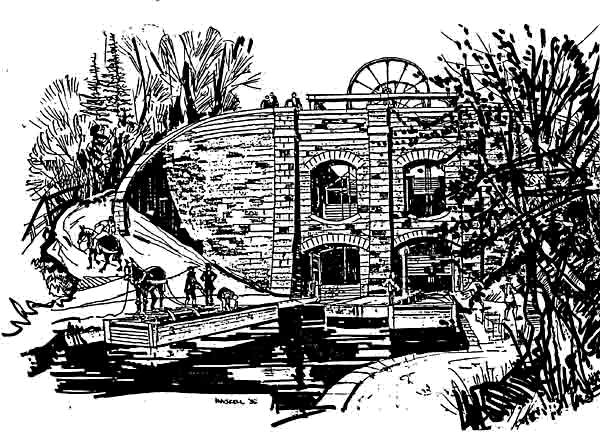CANAL TUB BOATS
Brindley's Trent and Mersey Canal had set the narrow boat standard on British canals in 1860's but when engineers began to plan the extension of canals into terrain where the use of ordinary pound locks was likely to prove difficult owing to sharp contours, or lack of water, the use of smaller than normal canal boats was contemplated. They became known as tub-boats.
The winding river valleys and steep, rough hillsides found in Devon and Cornwall are typical of the difficult terrain that challenged the early engineers. Sea sand, carried inland from many of the Cornish and Devon beaches was in great demand as a soil conditioner and schemes such as the St. Columb Canal (1773) and the Bude Canal (1819) were initiated.

A conjectural view of a Grand Western Canal Lift by Tony Haskell
The idea of using inclines or lifts was attractive because techniques and materials of the period were not capable of dealing with full size canal boats. They could also be economical with water when compared with locks. The inclined plane concept had been in existence since ancient times and the earliest device discovered is in Egypt at Mirgissa, c.1700 BC.
Most of the recorded discussion and writings about tub-boat canals appeared to take place in the South West and water powered lifts or inclines were proposed because coal for steam power was expensive to import. At about the same period the iron smelting activities of the Iron Bridge Gorge area of Shropshire created a demand for a transport system to carry the iron ore, limestone and coal to the smelting sites. Small canal systems with tub boats were introduced, some times the canals going into the mines themselves. Changes of level were achieved using inclined planes and six successful systems were built. The first was William Reynolds's self-acting incline on the Ketley Canal built in 1788. The remaining five, built on the Shropshire Canal, were a modification of the Reynolds design and were steam powered. Coal was cheap in this area and the inclines very successful, so much so that Thomas Telford thought that the success of the tub boat system showed that artificial waterways could be built anywhere.
In 1817 the final version of the Bude Canal was proposed and James Green and James Shearn were invited to survey the line. A tub boat canal based on the principles of Robert Fulton, using waterpower for the inclines, was proposed and construction commenced in 1819 with James Green as Engineer. The tub boat section operated until 1891 when it was closed after a reasonably successful life but marred by the inadequacies of the materials of the day. The chains hauling the 5-ton boats up and down the inclines used to break frequently.
In 1829 the Grand Western Canal Company decided to link their Devon section, opened in 1814 with the Bridgwater and Taunton Canal in Taunton. The 13-mile section presented a difference in level of 262 feet, to be cut through exceedingly broken country at the western end. Clearly the rough terrain and unreliable water supply would make a full size canal very expensive to construct. James Green's proposal for a tub boat canal seemed the ideal solution. It would be cheap to build and economical with water. At a general meeting of the canal proprietors on 13th April 1830 a scheme using seven boat lifts and one inclined plane using 8-ton tub-boats was proposed and accepted.
Technology advanced rapidly from the 1830's onwards and improved materials and engineering techniques obviated the need for tub-boat systems as greater loads could be raised satisfactorily and construction and water supply problems more readily overcome. In their day tub-boat systems provided the canal builders with a successful engineering solution to rough terrain and water shortage problems but most were unprofitable because of the one-way or erratic trade characteristics of the rural areas in which they were built, the exception being the Shropshire industrial area tub-boat canals.
